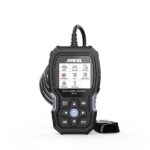Seeing the ‘check engine’ light illuminate on your dashboard can be stressful, especially when you’re unsure of the cause. That’s why understanding OBD2 fault codes in Spanish free (códigos de falla OBD2 en español gratis) can be incredibly helpful. These Diagnostic Trouble Codes (DTCs) can provide valuable insight into your vehicle’s issues, allowing you to identify problems and take appropriate action.
What is a DTC Code?
A DTC, or Diagnostic Trouble Code, is a code used to pinpoint malfunctions in a vehicle or heavy equipment. While the malfunction indicator lamp (MIL), commonly known as the check engine light, simply alerts drivers to a problem, a DTC specifies the nature and location of the issue. DTCs are also referred to as vehicle engine fault codes and can be accessed using a scan tool that connects directly to a vehicle’s diagnostic port.
A basic understanding of DTCs can be beneficial for both drivers and fleet managers. Keep reading to learn more about DTCs, how they work, and how you can interpret them, and even find resources for OBD2 fault codes in Spanish free.
Where Do DTCs Come From?
DTCs are generated by the vehicle’s On-Board Diagnostics (OBD) system whenever a fault is detected. The OBD system diagnoses the fault and signals the DTC through visible warnings, such as illuminating the check engine light. It also enables external devices, like OBD scanners, to interact with the vehicle’s onboard computer system.
Over the years, various OBD interface versions, now categorized as OBDI, were used, with significant variations between manufacturers. Today, two primary standards are used for reading DTCs:
- OBD2: Best suited for light- and medium-duty vehicles.
- J1939: Ideal for heavy-duty vehicles and equipment.
With the introduction of OBDII, the Society of Automotive Engineers (SAE) developed a standardized list of DTCs containing fault codes common across all manufacturers.
While OBDII is widely adopted, it’s important to remember that manufacturer-specific DTCs still exist. Manufacturers can create their own DTC codes to supplement the universal list if necessary for their vehicles. However, these manufacturer-specific codes are often challenging to interpret without specialized mechanic knowledge.
Does Your Vehicle Use OBDII or J1939?
OBDII Compatible:
- Cars and light trucks manufactured and sold in North America after January 1, 1996, were mandated to be equipped with OBD-II.
J1939 Compatible:
- Most vehicles or equipment with diesel engines are J1939 compatible.
- It is the industry standard for most heavy-duty trucks and buses.
If you are unsure whether your vehicle is OBDII or J1939 compliant, consult your vehicle’s manual, research online, or check with your dealership for confirmation.
How to Read an OBDII DTC Code?
DTC codes consist of five characters. Each character in the DTC provides different information about the vehicle’s problem.
The first character is always a letter, indicating the control system with the issue. The possible values and meanings are:
- P (Powertrain): Refers to the engine, transmission, fuel system, and related accessories.
- C (Chassis): Pertains to mechanical systems generally outside the passenger compartment, such as steering, suspension, and braking.
- B (Body): Relates to parts primarily located within the passenger compartment area.
- U (Network): Refers to the vehicle’s onboard computer and related systems.
The second character is a digit, typically 0 or 1, indicating whether the code is standardized:
- 0: Indicates a generic, standardized SAE (Society of Automotive Engineers) code. All vehicles complying with the OBDII standard adopt generic codes.
- 1: Indicates a manufacturer-specific code. These codes are unique to a specific car brand or model and are generally less common.
- 2 or 3: Rarer and their meanings depend on the preceding letter in the code. Most often, 2 or 3 indicate a manufacturer-specific code, with few exceptions.
The third character is also a digit, ranging from 1 to 8. This reveals the subsystem at fault:
- 1: Refers to the fuel or air metering system.
- 2: Refers to the fuel or air metering injection system.
- 3: Refers to the ignition system.
- 4: Refers to the emission control system.
- 5: Refers to vehicle speed controls and the idle control system.
- 6: Refers to the computer output circuit.
- 7 and 8: Indicate a transmission-related issue.
The fourth and fifth characters are read together as a two-digit number between 0 and 99, known as the specific fault index. These digits pinpoint the exact vehicle problem.
If you’re unsure about the meaning of your code, consult your vehicle manufacturer or your manual for further explanation. You can also find resources online for OBD2 fault codes in Spanish free that may offer interpretations.
How to Interpret a DTC?
Each DTC corresponds to a specific vehicle malfunction, such as a misfire in engine cylinder one. Here’s an example of how to read a common DTC: P0128.
- The first letter is P, indicating the problem is in the Powertrain.
- The second character is 0, meaning the code is not manufacturer-specific. It’s standardized and interpretable according to SAE definitions.
- The third character is 1, revealing the issue is specifically within the fuel and air metering subsystem.
- The last two digits form the specific fault index 28.
Based on this reading, it’s clear that code P0128 refers to an engine coolant temperature issue where the temperature is below the thermostat regulating temperature.
Alt text: Decoding OBD2 fault codes to diagnose car problems.
What are Common DTCs?
Some DTC codes are more frequently encountered than others. Here is a list of common DTCs and their corresponding malfunctions:
- P0442: Small Evaporative Emission System Leak Detected.
- P0606: PCM (Powertrain Control Module) Malfunction, also known as ECM (Engine Control Module).
- P0101: Mass Air Flow (MAF) Sensor Circuit Range/Performance Problem.
- P0110: Intake Air Temperature Sensor Circuit Malfunction.
- P0500: Vehicle Speed Sensor Malfunction.
- P0706: Transmission Range Sensor Circuit Range/Performance.
It’s crucial to remember that while DTCs are helpful for identifying a vehicle’s malfunction, they don’t explain the underlying cause. Further diagnosis by a mechanic is necessary to identify and address the root cause of the problem. Resources for OBD2 fault codes in Spanish free can help you understand the initial code, but professional diagnosis is recommended for repair.
How to Read a J1939 DTC Code?
A J1939 DTC contains four fields that convey information about the reported fault:
- Suspect Parameter Number (SPN): Represents the faulty SPN. Every defined SPN can be used in a DTC.
- Failure Mode Identifier (FMI): Represents the nature and type of error, such as value range violation (high or low), sensor shorts, incorrect update rate, or calibration error.
- Occurrence Count (OC): A counter that tracks the occurrence of the error condition for each SPN and stores it even when the error is no longer active.
- SPN Conversion Method (CM): Defines the byte alignment within the DTC. A value of “0” represents the method shown in the “Structure of a DTC” chart. If CM has a value of “1”, a distinction must be made between three previously valid methods, which should be known to the system.
Alt text: Structure of a J1939 DTC code for heavy-duty vehicles.
DTC Scanning Tools for Fleet Managers
Scanners that read DTCs, known as OBDII scanners, are widely available for purchase. However, if you’re a fleet manager responsible for multiple vehicles, manually checking each vehicle whenever the check engine light comes on can be inefficient.
This highlights the importance of selecting a fleet management solution, like Samsara, that includes maintenance tools to streamline DTC identification. Samsara vehicle gateways connect directly to the vehicle’s OBDII port and transmit relevant data to the cloud, including DTCs. This means that if a DTC occurs, it automatically appears on your Samsara dashboard, or you can opt to receive notifications via alerts.
When multiple vehicles in your fleet experience DTC issues, a telematics solution with a DTC tool can help you quickly identify the problems. This allows you to promptly schedule necessary maintenance and minimize downtime. While searching for OBD2 fault codes in Spanish free might be helpful for initial understanding, fleet management systems offer a more comprehensive and efficient solution for businesses.
Understand DTCs Easily with Telematics
Seeing a check engine light without knowing the reason can be stressful. That’s why leveraging a telematics solution can be invaluable in understanding Diagnostic Trouble Codes (DTCs). These systems can help you swiftly identify vehicle problems and take appropriate actions.
Samsara’s vehicle gateway directly connects to a vehicle’s OBDII or J1939 port, transmitting DTC-related information directly to the Samsara dashboard. Furthermore, alerts can be activated for DTC occurrences using the “Vehicle Fault” alert feature. You can also utilize Samsara’s DTC filtering feature to receive alerts for the most critical DTCs for your fleet.
To learn more about how Samsara can assist you in reading and addressing DTCs, sign up for a free trial or explore Samsara’s fleet maintenance solutions for efficient vehicle management and understanding OBD2 fault codes in Spanish free within a broader fleet context.

